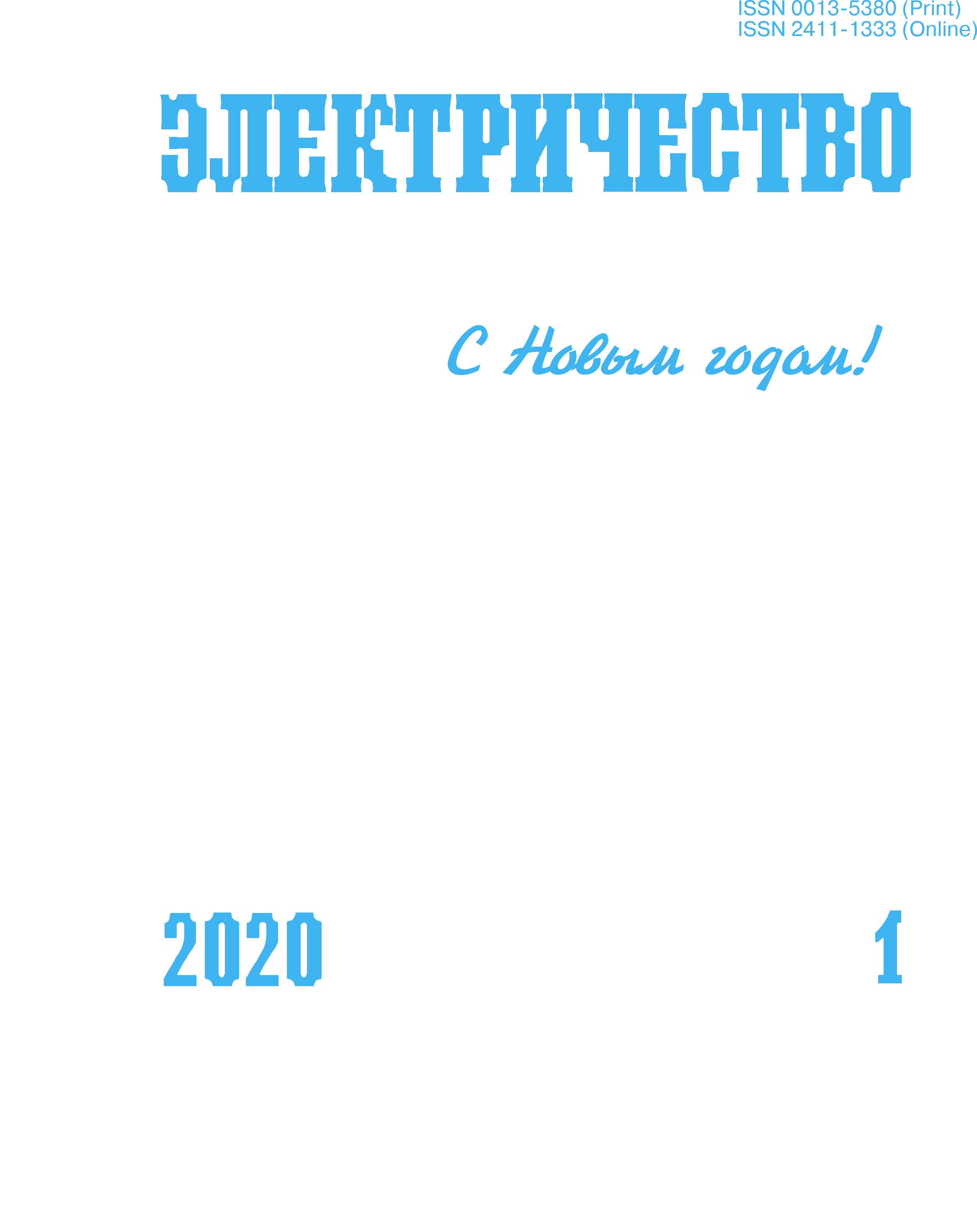Electromagnetic Compatibility of the Electrical Installations of Non-Traction Loads and the Power Supply System with a High-Voltage Power Lead
Abstract
A procedure for calculating switching overvoltages, including those that occur when lightning currents discharge in a power supply system’s contact system with a high-voltage power lead, is substantiated. It has been found that the floor-mounted signaling arrangements can be protected from switching overvoltages in the power supply system with a high-voltage power lead (HVPL PSS) by connecting the contact system supports with a long grounding conductor laid in the ground and not connected with the railway. An algorithm for simulating the spectral composition of zero sequence phase voltage components in overhead power lines with the insulated neutral with respect to ground in the case of their location in the HVPL PSS electromagnetic influence zone and the presence of a zero sequence voltage filter (ZSVF). If the studied system does not contain a ZSVF, this results in a multifold increase of the power line zero sequence voltages, imbalance of the phase voltages, and the occurrence of interference both at the line beginning and end points. The use of filters made it possible to smooth and flatten the spectral composition of voltage and to minimize the effect of resonance phenomena at high frequencies.
References
2. Мамошин Р.Р. Повышение качества энергии на тяговых подстанциях дорог переменного тока. М.: Транспорт, 1973, 315 с.
3. Косарев А.Б. Основы теории электромагнитной совместимости системы тягового электроснабжения переменного тока. М.: ИНТЕКСТ, 2004, 272 с.
4. А.с. № 1689143 А1. Система тягового электроснабжения участков переменного тока/Т.К. Асанов, Б.И. Косарев, Р.И. Караев, С.Ю. Петухова. - БИ, № 4, 3 с.
5. Косарев А.Б., Косарев Б.И. Электромагнитная совместимость электроустановок и сетей нетягового электроснабжения с электрифицированными железными дорогами переменного тока. — Электроника и электрооборудование транспорта, 2016, № 5, с. 39—44.
6. Петухова С.Ю. Усиление тяговых сетей переменного тока использованием распределённого питания и провода повышенного напряжения: Дис.... канд. техн. наук. М.: МИИТ, 1994, 156 с.
7. Косарев А.Б., Косарев Б.И. Основы электромагнитной безопасности систем электроснабжения железнодорожного транспорта. М.: ИНТЕКСТ, 2008, 480 с.
8. Косарев А.Б., Логинов С.В. Повышение надежности работы устройств автоблокировки за счет отказа от использования рельсовых путей для заземления опор контактной сети переменного тока. — Вестник ВНИИЖТ, 2009, № 2, с. 9—12.
9. Долгинов А.И. Техника высоких напряжений в электроэнергетике. М.: Энергия, 1968, 464 с.
10. Караев Р.И., Косарев Б.И. Схемы замещения стального рельса в переходном режиме. — Электричество, 1968, № 7, с. 11—15.
11. Правила устройства системы тягового электроснабжения железных дорог Российской Федерации. М.: Транспорт, 1999, 77 с.
12. Фельдбаум А.А. Введение в теорию нелинейных цепей. М.: Госэнергоиздат, 1948, 324 с.
13. Косарев А.Б., Косарев Б.И. Расчёт параметров электрического поля с неоднородной злектрической структурой земли при стекании тока с искусственного заземлителя. — Электроника и электрооборудование транспорта, 2016, № 3, с. 8—12.
14. Косарев А.Б., Косарев Б.И., Сербиненко Д.В. Электромагнитные процессы в системах электроснабжения железных дорог переменного тока. М.: LLC ООО «ВМГ-Принт», 2015, 348 с.
#
1. Markvardt K.G. Elektrosnabzheniye elektrifitsirovannykh zheleznykh dorog (Electricity supply for electrified railways). Moscow, Transport, 1982, 528 p.
2. Mamoshin R.R. Povysheniye kachestva energii na tyagovykh podstantsiyakh dorog peremennogo toka (Improvement of electric power quality at AC railway traction substations). Moscow, Transport, 1973, 315 p.
3. Kosarev A.B. Osnovy teorii elektromagnitnoi sovmestimosti sistemy tyagovogo elektrosnabzheniya peremennogo toka (Fundamentals of the AC traction power supply system electromagnetic compatibility theory). Moscow, INTEKST, 2004, 272 p.
4. A.s. No. 1689143 А1. Sistema tyagovogo elektrosnabzheniya uchastkov peremennogo toka (The traction power supply system of AC segments). Bulletin of inventions, 1991, No. 4, 3 p.
5. Kosarev A.B., Kosarev B.I. Elektronika i oborudovaniye transporta — in Russ. (Electronics and electrical equipment of transport), 2016, No. 5, pp. 39-44.
6. Petukhova S.Yu. Usileniye tyagovykh setei peremennogo toka ispol’zovaniyem raspredelennogo pitaniya i provoda povyshennogo napryazheniya: dis.... kand. tekhn nauk (Strengthening of AC traction networks by using distributed power supply and an increased voltage lead). Moscow, MIIT, 1994, 156 p.
7. Kosarev A.V., Kosarev B.I. Osnovy elektromagnitnoi bezopasnosti zheleznodorozhnogo transporta (Fundamentals of the electromagnetic safety of railway transport power supply systems). Moscow, INTEKST, 2008, 480 p.
8. Kosarev A.B., Loginov S.V. Vestnik VNIIZhT — in Russ. (Bulletin of VNIIZhT), 2009, No. 2, pp. 9-12.
9. Dolginov A.I. Tekhnika vesokikh napryazhenii v elektroenergetike (High voltage technology in the electric power industr). Moscow, Energiya, 1968, 464 p.
10. Karaev R.I., Kosarev B.I. Elektrichestvo — in Russ. (Electricity), 1968, No. 7, pp. 11-15.
11. Pravila ustroistva sistemy tyagovogo elektrosnabzheniya zheleznykh dorog RF (Codes for designing the traction power supply system for the Russian Federation railways). Moscow, Transport, 1999, 77p.
12. Fel’dbaum A.A. Vvedeniye v teoriyu nelineinykh tsepei (Introduction to the theory of nonlinear circuits). Moscow, Gosenergoizdat, 1948, 324 p.
13. Kosarev A.B., Kosarev B.I. Elektronika i elektrooborudovaniye transporta — in Russ (Electronics and electrical equipment of transport), 2016, No. 3, pp. 8-12.
14. Kosarev A.B., Kosarev B.I., Serbiyenko D.V.




